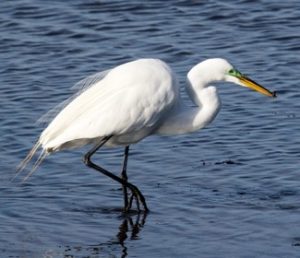Eastern Oyster
Crassostrea virginica

Image by Roberta Miller of Fisheries and Oceans Canada, CC-BY-NC-SA 4.0
Physical: Eastern oysters are bivalves with a soft body inside two rough shells, which are white to gray in color. The bottom shell is cupped, with a purple muscle scar on the inside. Eastern oysters are 150-250 cm in length.
Habitat: They live in shallow estuarine water along the Atlantic coast. They prefer a firm substrate, and attach to each another, forming beds or reefs that provide habitat for many fish and invertebrate species.
Feeding: Eastern oysters are filter feeders, consuming plankton by opening their shells and pumping water through their gills.
Breeding: Adults spawn (release eggs and sperm into the water) in early summer as water temperatures warm. Fertilized eggs develop into free-swimming larvae. After a couple of weeks of growth, larvae “settle” on a hard surface, where they attach by secreting a cement-like substance. The settled larvae are called “spat.”

Sign up for email or connect through social media.